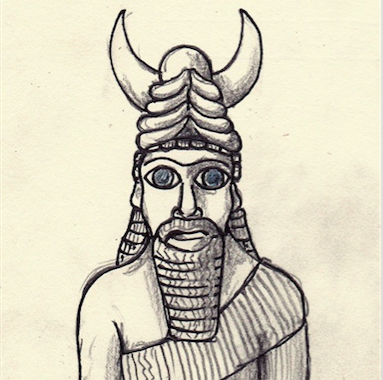Well, I grew up with this story—of course the way my Father told it to me. And my teammates, Josh and Sam grew up with it the way their Father told it. And the stories, are close but with significant differences. How do we depict it in our movie where we need it? You probably heard it the Josh and Sam way. Here’s mine first:
Abram, of course, grew up in Ur—the Sumerian pilgrimage town devoted to the Moon God Nammu/Sin. His Father, Terach made idols (the name ‘Terach’ essentially meaning Moon worshipper). The story goes—one day Terach was heading out to market, and asked little Abram to watch the shop. Abram starting playing with the idols, and oops—he broke one. He knew he’d get into trouble for it, and as a result, kept playing and smashed them all. When Terach came home, he of course was horrified.
“What happened?” he asked?
“They started fighting,” the precocious boy said. The gods, after all, were known for their fierce tempers and competitive spirit.
“How could they start fighting if they’re merely made of clay?” Terach said, not having any of it.
And there’s the ‘Aha!” moment for Abraham. That idols could not be gods. And that a unified single principle of God superseded them all. A lovely Just-So story.
Josh and Sam (and probably you) grew up with Abraham smashing the idols on purpose, knowing already that they were false. Still a Just-So story. But I don’t like it. It’s a little too Taliban smashing the ancient Buddhas carved into the mountainside at Bamiyan, Afghanistan. I love Abraham, and I don’t want him being a sociopathic zealot as a child. I’d much rather he discover something transcendent and filled with wonder. It matters.
In other words, I prefer my Father’s telling to yours. And as you know, the movie we’re making honors my Father, so that’s that.
So okay. We’re making a movie, right? An animation. How do we depict this story with few words, and only a few seconds to spare. Can it even be done?
I picture Terach’s shop as a kind of souvenir shop for pilgrims. They can purchase statues and figurines for their altar niches at home, for prayer and meditation. Good. But which gods? Was it only Sin/Nammu or the others as well? And around 2500 BCE what did the gods look like in what we now call southern Iraq? I can picture just Nammu in the shop: very ‘Being John Malkovich’, with all the fighting Moon Gods exactly the same. Is that, perhaps de trop?
I consulted with one of my favorite archaeologists about such questions, and we talked possibilities. Including the business strategies of souvenir shops at pilgrimage sites. We decided that if Terach was a good businessman, he’d have had a number of popular gods for sale in his shop.
And what did they look like? Funny you should ask. In that period, the gods were depicted primarily sitting down, while petitioners and worshippers stood. The gods remained on their thrones. Their eyes and ears were oversized because gods see and hear it all. Their eyes were inset with lapis lazuli—sparkling, bright and the best kind of blue. Upon their heads were markers of their specialties. And Nammu/Sin had the crescent moon upon his head, with the sun disk in the center.
Think of it. Abram playing He-Man and Skeletor with his Father’s idols as they sit upon their thrones. Easy to see how he found the gods unlikely sources of power, rage, and authority if they never even stood up.
I’m not sure we need the scene, but I think we do. Either way, it’s taking us on a journey revisiting a beloved old tale that I’m taking both more seriously these days and less so as well.
—Mira Z Amiras

